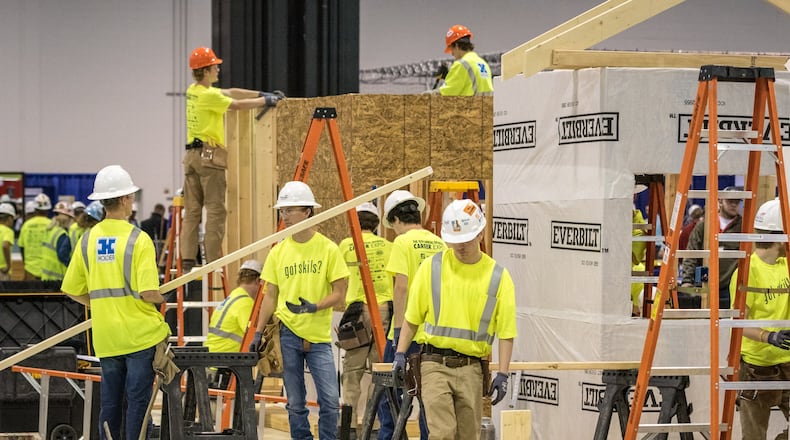A multimillion-dollar grant is intended to address a pressing problem that the building boom across the county and especially in metro Atlanta has exacerbated — the lack of workers in the skilled construction trades.
The Arthur M. Blank Family Foundation, The Home Depot Foundation and The Marcus Foundation have created a partnership to address that need. The $5.7 million grant will enable the Construction Education Foundation of Georgia to expand existing programs and create new ones.
Scott Shelar, CEO and president of CEFGA, said, “This watershed funding effort will make a significant impact on students across the state, while simultaneously helping industry partners see tangible results as more skilled professionals join the workforce.”
The initiative aims to build the construction workforce while teaching students in-demand skills and connecting them to clear career pathways in the skilled trades.
Related story: Programs expose metro Atlanta students to construction industry
Related story: Gwinnett students build tiny libraries in big literacy project
CEFGA was created in 1993 by construction employers. The three-year investment will let it:
● Expand the number of elementary and middle school construction programs from nine to at least 20 across the state.
● Expand the number of industry-certified high school construction programs in Georgia from 42 to more than 80.
● Expose more than 21,000 students to careers in construction.
● Provide training and industry credentials to more than 17,500 students.
● Place at least 3,500 students in work-based learning and full-time employment opportunities in the construction industry.
The program isn’t just for boys.
“With the shortages so great I wouldn’t eliminate half of potential workers,” said Shelar. “Even though women make up a small percentage of construction employees, that number is growing.”
A recent report by Kennesaw State University found that 83 percent of construction companies surveyed said staffing was their biggest business challenge. The Georgia Department of Labor estimates 271,529 skilled jobs will be needed by 2022.
Bernie Marcus, The Home Depot co-founder and Chairman of The Marcus Foundation said, "I've been concerned for a number of years that students have been told that if they don't get a college education they can't succeed. It's not true. And it hasn't been true since I was a kid. Many people have been successful after learning a trade. It helps make the world 'work.' Our country has grown and prospered because of electricians, plumbers, and all kinds of construction workers in every generation. Having a skill in a trade today can lead to a great job, no college debt, and the ability to provide for a family."
Arthur Blank, The Home Depot co-founder and chairman of the Arthur M. Blank Family Foundation, agreed.
“We believe in the power of workforce development programs to provide living wage jobs and long-term economic mobility,” he said, citing a project with CEFGA that “has placed nearly 400 Westside (Atlanta) residents into construction jobs. We look forward to working together to provide additional meaningful opportunities for students across Georgia.”
CEFGA works closely with the Georgia Department of Education and local school systems throughout the state. The new partnership will let it expand its K-12 program across Georgia and build a concept that could be implemented in other states.
Shelar cited the model used in the Roswell cluster of Fulton County schools as something he’d like to replicate. Mike Looney, Fulton County school superintendent, said the district “is eager to expand existing efforts in elementary and middle schools. I have personally seen the benefit of students acquiring and applying new skills related to the construction industry.”
Shelar has seen interest in the skilled construction trades grow. The annual CEFGA Expo has outgrown its space at the Georgia International Convention Center. Beginning this year is will be housed at the Georgia World Congress Center.
CEFGA’s 2020 CareerExpo is set for March 12 - 13 at the Georgia World Congress Center. More than 5,000 middle, high school and college students from across Georgia will come to learn about careers in the building industry and speak with professionals from 300-plus leading companies.
Information: cefga.org/careerexpo
Construction trade by the numbers
311,000 — number of unfilled construction jobs in the United States
6,000 — number of unfilled construction jobs in Georgia
3,000 — number of unfilled construction jobs in metro Atlanta
6% — percent of females in the construction field
14% — percent of females enrolled in career-ready construction programs
Source: U.S. Bureau of Labor Statistics; CEFGA
Introducing the Next Generation to the Skilled Trades
The new CEFGA K-12 pipeline led by The Marcus Foundation, The Arthur M. Blank Foundation and The Home Depot Foundation will start with students in the fifth grade.
The after-school program will give them hands-on experience with tools and materials.
“It doesn’t take away from other schools courses and it comes at no cost,” said Scott Shelar, CEO and president of CEFGA. “And for kids who are visual and tactile learners, it will give them something extra at school to look forward to.
In middle schools, students can take construction courses as their elective classes.
In high schools, CEFGA wants to expand existing programs before creating construction classes in schools that don’t have them.
About the Author
Keep Reading
The Latest
Featured



